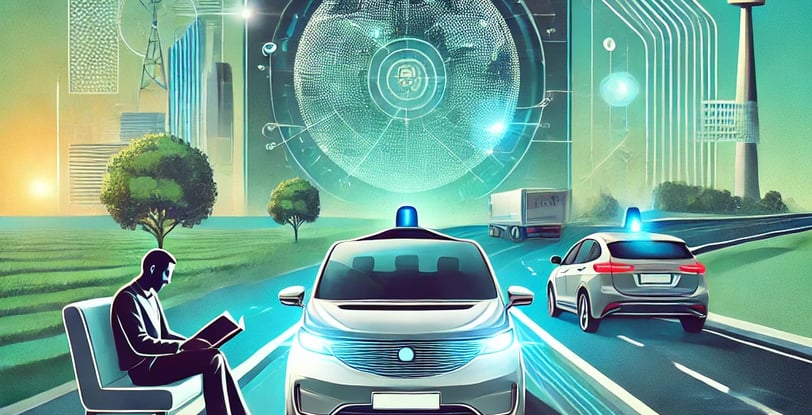How Self-Driving Cars Are Changing the Way We Travel
Last summer, I had the chance to sit in a self-driving car for the first time. Let me tell you, it was both thrilling and unnerving. As the car maneuvered through city streets, obeying traffic lights and keeping a safe distance from pedestrians, I couldn’t help but think: Is this really the future of transportation? Self-driving cars aren’t just a sci-fi dream anymore; they’re a reality that’s reshaping how we think about travel. In my opinion, they’re the most exciting (and slightly intimidating) innovation in the automotive world today.
Laksh Rathore
11/30/20243 min read


How Self-Driving Cars Are Changing the Way We Travel
Introduction: A Glimpse Into the Future
Last summer, I had the chance to sit in a self-driving car for the first time. Let me tell you, it was both thrilling and unnerving. As the car maneuvered through city streets, obeying traffic lights and keeping a safe distance from pedestrians, I couldn’t help but think: Is this really the future of transportation? Self-driving cars aren’t just a sci-fi dream anymore; they’re a reality that’s reshaping how we think about travel. In my opinion, they’re the most exciting (and slightly intimidating) innovation in the automotive world today.
But how exactly are these autonomous vehicles changing the way we travel? Let’s explore.
Convenience Like Never Before
Imagine this: You’re on your way to a road trip, and instead of focusing on the road, you’re catching up on your favorite Netflix series or even getting some work done. Self-driving cars promise unparalleled convenience, turning commutes into productive or relaxing time.
A Personal Experience
During my ride in a self-driving car, I noticed how it handled mundane tasks—like stop-and-go traffic—with ease. It felt like having a personal chauffeur who never gets tired or distracted. What I’ve learned is that these cars aim to make traveling as effortless as possible.
The Numbers Speak
According to a study by McKinsey, self-driving cars could save commuters up to 50 minutes per day by taking over the driving responsibilities. Over a year, that’s over 300 hours of reclaimed time! For busy professionals and families, this kind of convenience is priceless.
My Takeaway
In my opinion, this time-saving aspect is one of the biggest selling points of autonomous vehicles. Whether you’re catching up on emails or just taking a nap, self-driving cars give you the freedom to make the most of your journey.
Improved Safety: Fewer Accidents, More Lives Saved
One of the biggest promises of self-driving cars is enhanced safety. Human error causes 94% of traffic accidents, according to the National Highway Traffic Safety Administration (NHTSA). Autonomous vehicles, with their advanced sensors and algorithms, could drastically reduce this number.
A Relatable Thought
We’ve all been there—a moment of distraction at the wheel, whether it’s checking a text or adjusting the radio. I know I’ve had close calls, and it’s scary to think how quickly things can go wrong. What if technology could prevent those mistakes?
The Technology Behind It
Self-driving cars are equipped with LiDAR, cameras, and radar systems that can detect obstacles, predict potential collisions, and react faster than any human. Tesla’s Autopilot and Waymo’s AI systems are examples of this cutting-edge tech. In fact, a study by RAND Corporation estimates that widespread adoption of autonomous vehicles could prevent up to 90% of road fatalities.
What I Think
In my opinion, this is where self-driving cars truly shine. If these vehicles can save even a fraction of the 1.35 million lives lost globally to road accidents each year, they’re worth every bit of investment.
Changing the Urban Landscape
Autonomous vehicles don’t just affect how we travel; they’re also reshaping our cities. Imagine a world with fewer parking lots, optimized traffic flow, and reduced congestion. Sounds like a dream, right?
A Thought Experiment
During my daily walks to class, I often notice how much space is dedicated to parking lots. What if those spaces were turned into parks or housing instead? Self-driving cars, with their potential for shared usage, could make that a reality.
The Research Backs It Up
A report by the International Transport Forum predicts that shared autonomous vehicles could reduce the number of cars on the road by 90% in some urban areas. With fewer vehicles, we could see less pollution, better land use, and cleaner cities.
My Take
For students like me, who dream of greener, more efficient cities, self-driving cars offer incredible potential. They’re not just about personal convenience; they’re about creating a better world for everyone.
Conclusion: The Road Ahead
Self-driving cars are more than just a cool gadget; they’re a transformative force in transportation. From reclaiming our time to saving lives and reshaping cities, their impact is undeniable. Personally, I think these cars represent the future we’ve all been waiting for—one where travel is safer, smarter, and more sustainable. Of course, challenges remain, like regulatory hurdles and public trust. But what I’ve learned is that innovation always comes with growing pains.
So, the next time you’re stuck in traffic or nervously gripping the wheel, imagine a world where you could sit back, relax, and let technology do the work. It’s not as far away as it seems.
